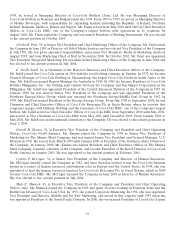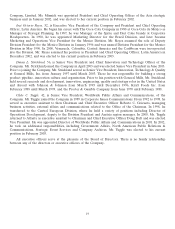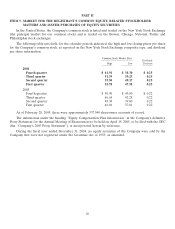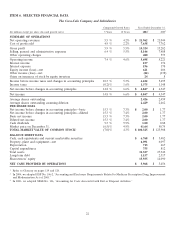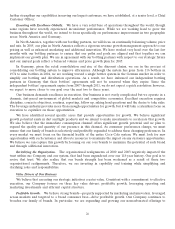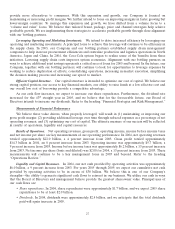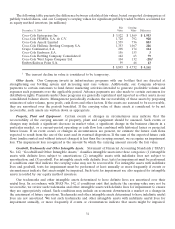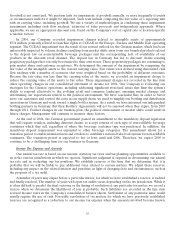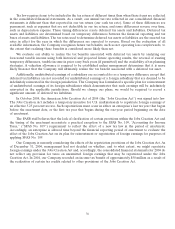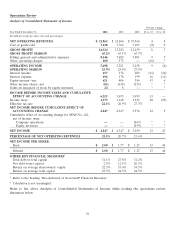Coca Cola 2004 Annual Report Download - page 30
Download and view the complete annual report
Please find page 30 of the 2004 Coca Cola annual report below. You can navigate through the pages in the report by either clicking on the pages listed below, or by using the keyword search tool below to find specific information within the annual report.
•Capital expenditures. In 2004, capital expenditures were $755 million, and we expect 2005 capital
expenditures to again be less than $1 billion.
Refer to the heading ‘‘Liquidity, Capital Resources and Financial Position.’’
Challenges, Risks and Opportunities
Operating in more than 200 countries provides unique opportunities for our Company. Challenges and risks
accompany these opportunities. Our Company’s strengths, strategic initiatives and value drivers provide the
foundation for our response to the challenges, risks and opportunities before us.
Looking forward, management has identified certain challenges and risks that demand the attention of the
beverage industry and our Company. Of these, four key challenges and risks are discussed below.
Obesity and Inactive Lifestyles. Increasing consumer, public health and government awareness of the health
problems arising from obesity and inactive lifestyles represents a significant challenge to our industry. We
recognize that obesity is a complex and serious public health problem. Our commitment to consumers begins with
our broad product line, which includes a wide selection of diet and light beverages, juices and juice drinks, sports
drinks and water products. Our commitment also includes adhering to responsible policies in schools and in the
marketplace; supporting programs to encourage physical activity and to promote nutrition education; and
continuously meeting changing consumer needs through beverage innovation, choice and variety. We are
committed to playing an appropriate role in helping address this issue in cooperation with governments, educators
and consumers through science-based solutions and programs. As part of that commitment, in 2004, our Company
created The Beverage Institute for Health & Wellness (the ‘‘Institute’’), which is based in Houston, Texas. The
Institute is an organization that supports scientific research, education and outreach with a primary focus on
beverages. The Institute supports research to help better understand the role that beverages can play in diets and
health in both developed and developing countries around the world. This effort may lead to the creation of new
beverage products by the Company in addition to providing health and nutrition education.
Water Quality and Quantity. Water quality and quantity is an issue that increasingly requires our Company’s
attention and collaboration with the beverage industry, governments, nongovernmental organizations and
communities where we operate. Water is the main ingredient in every product the beverage industry offers. It is
also a limited natural resource facing unprecedented challenges from over-exploitation, increasing pollution and
poor management.
Our Company and the beverage industry are in an excellent position to share the water expertise we have
developed in the communities we serve—in source management, unique multiple barrier water treatment,
advanced wastewater treatment systems, rainwater harvesting and use of emerging innovative technologies such as
desalination. As demand for water continues to increase around the world, we expect commitment and continued
action on our part will be crucial in the successful long-term stewardship of this critical natural resource.
Evolving Consumer Preferences. Consumers want more choices. We are impacted by shifting customer
demographics and needs, on-the-go lifestyles, aging populations in developed markets and consumers who are
empowered with more information than ever. We are committed to generating new avenues for growth through
our core brands with a focus on diet and light products. We are also committed to providing consumers with a
wide variety of choices to meet these needs, desires and lifestyle choices.
Increased Competition and Capabilities in the Marketplace. Our Company is facing strong competition from
some well established global companies and many local players. We must continue to selectively expand into
other profitable segments of the nonalcoholic beverage industry and re-energize our marketing and innovation
in order to maintain our brand loyalty and share.
All four of these challenges and risks—obesity and inactive lifestyles, water quality and quantity, evolving
consumer preferences and increased competition—have the potential to have a material adverse effect on the
beverage industry and on our Company; however, we believe our Company is well positioned to appropriately
address these challenges and risks.
28


